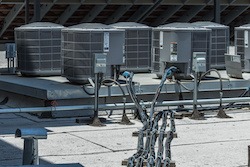One of the most important systems within your home is the furnace, or system you use to heat your home when it gets cold. When your furnace is not operating at an efficiency level that it should be, that can lead to a slew of issues. When determining if you need to replace your furnace with a new unit, it’s important to know the signs.
Following are 5 clear signs that if you’re experiencing, you should consider turning in your old furnace, with a new, energy efficient one.
1. Age
One of the benefits of modern furnaces is that they are much more durable than before, and many companies offer warranties to back that up. That being said, many houses in New England are not equipment with modern furnaces. A new furnace can last anywhere between twenty and thirty years, routine maintenance can strongly increase the lifespan of your furnace. If your furnace is getting close to the far end of that range, you may want to look into getting a replacement, or having a tech check the health of your furnace.
2. Increased Energy Bill
In New England we are no strangers to variance in our heating costs. With a mix of mild and harsh winters, heating bills can change from year to year, but if you’re noticing an increasing trend in your heating bill, this may be a sign of degradation. As a furnace ages, it becomes much less efficient in providing heat to your home. The root cause of this can be a number of small to large issues, but the efficiency of your furnace has a direct effect on your heating bill.
3. Uneven Heating
Have you ever turned the heat on and realized that one room was much colder than the others? Or that you have the heat at 65 degrees and it feels like 80 degrees in your kitchen and 30 degrees in the bathroom? Uneven heating is almost always caused by some sort of breakdown within your heating system. The solution to this can be as simple as clearing blockage in your ducts, or as bad as a breakdown in your furnace.
The symptom of uneven heating is easy to ignore but if you notice this in your home, you should act fast to get it repaired so that a smaller problem does not snowball into something much more expensive.
4. Air Quality
Have you noticed a decrease in the air quality of your home? This can be in the form of dryness, dust, or in some cases an increase in flu-like symptoms such as headaches and a dry throat. A decrease in air quality can point to a much larger problem such as a leak of carbon monoxide. A good way to confirm a carbon monoxide leak related to your furnace can be to look at the burner flame. If it is burning yellow, instead of blue, you have some carbon monoxide burning in there.
If you are noticing a decline in your homes air quality, you should focus on identifying the cause immediately.
5. Damage
The most obvious case can be the easiest to miss. If you have had damage to your furnace, or the number of repairs you have completed are starting to stack up, you should consider a replacement. Waiting until things are at a breaking point can be risky because furnaces almost always break during the winter, and in New England, that is the worst possible time for this too happen. Do yourself a favor, and complete a furnace replacement when you don’t necessarily need the system to be running.

